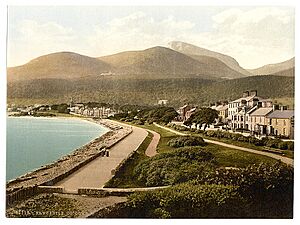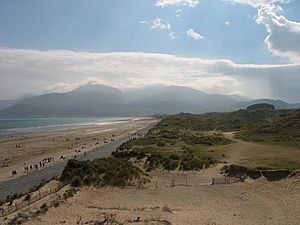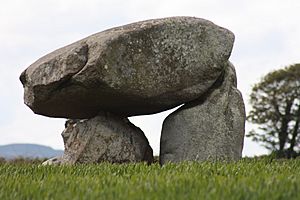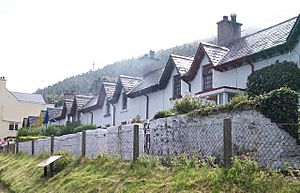Newcastle, County Down facts for kids
Quick facts for kids Newcastle
|
|
|---|---|
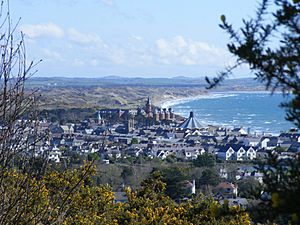 Newcastle from Donard Forest |
|
| Population | 8,298 2021 Census |
| • Belfast | 32.5 miles (52.3 km) |
| District |
|
| County | |
| Country | Northern Ireland |
| Sovereign state | United Kingdom |
| Post town | NEWCASTLE |
| Postcode district | BT33 |
| Dialling code | 028 |
| Police | Northern Ireland |
| Fire | Northern Ireland |
| Ambulance | Northern Ireland |
| EU Parliament | Northern Ireland |
| UK Parliament |
|
| NI Assembly |
|
Newcastle (Irish: An Caisleán Nua) is a fun seaside resort town in County Down, Northern Ireland. In 2021, about 8,298 people lived there. It sits right by the Irish Sea at the bottom of Slieve Donard, which is the tallest mountain in the Mourne Mountains. Newcastle is famous for its sandy beach, beautiful forests like Donard Forest and Tollymore Forest Park, and its amazing mountains. The town is part of the Newry, Mourne and Down District.
Newcastle wants to be known as Northern Ireland's "activity resort." It has a newly improved promenade (a walkway by the sea) and main street. The town is also connected with New Ross, a town in County Wexford, Republic of Ireland.
Contents
History of Newcastle
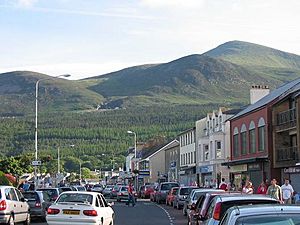
The town's name, Newcastle, likely comes from a castle built by Felix Magennis in 1588. This castle was located where the Shimna River meets the sea. Sadly, it was taken down in 1830. Records from 1433 already mention "New Castle," so it's possible Felix built his castle on the site of an even older one.
In the late 1700s, the castle was updated by different families. Around 1830, it was replaced by the 'Annesley Arms Hotel'. A new grand house called 'Donard Lodge' was also built on the mountain slope above the town, but it was demolished in 1966. St. John's Church opened in 1832 to welcome visitors and the growing number of people living in the town.
The Fishing Disaster of 1843
A very sad event happened on January 13, 1843. Fishing boats from Newcastle and Annalong went out to sea and were caught in a terrible storm. Fourteen boats were lost, and 73 men died. Forty-six of these men were from Newcastle. This left 27 widows and many children without their fathers. People raised money to help, and special cottages called Widows Row were built for the families. A local song about this disaster says, "Newcastle town is one long street entirely stripped of men."
Early Flight in Newcastle
In 1910, Harry Ferguson flew a small plane across Newcastle beach. This was one of the first times an engine-powered aircraft flew in Ireland! He was trying to win a £100 prize offered by the town. His first try didn't go well, but he then flew almost three miles along the beach. A plaque on the promenade remembers this amazing event.
Myths and Legends of the Mournes
The Mourne Mountains around Newcastle are full of local myths and legends.
- There are stories of 'The Blue Lady,' a ghost who is said to haunt the mountains.
- Some people believe a wild cat lives in the Mournes.
- 'Maggie's Leap' is named after a local girl named Maggie. Legend says she jumped over a huge gap to her death while running from soldiers.
- 'The Brandy Pad,' a path through the mountains, got its name because people used to illegally smuggle brandy along it.
- 'Bogey Hill,' near the harbour, is named after the carts (called 'bogies') that carried granite from Thomas Mountain down to the harbour.
In 1897, the Duke and Duchess of York (who later became George V and Queen Mary, grandparents to Queen Elizabeth II) visited Newcastle. They came to open the Slieve Donard Hotel.
Since 2014, people have been collecting old photos and information about Newcastle's history on a community Facebook page. This helps everyone learn more about the town's past.
Newcastle was lucky during the Troubles, a difficult time in Northern Ireland. People from different backgrounds generally lived together peacefully.
People in Newcastle
2021 Census Information
In 2021, there were 8,298 people living in Newcastle.
- About 69.1% of people were raised in or belong to the Catholic faith.
- About 21.7% were raised in or belong to Protestant and other Christian faiths.
- When asked about their national identity, 43.9% said they felt Irish, 37.4% felt Northern Irish, and 25.7% felt British. People could choose more than one identity.
2011 Census Information
In 2011, Newcastle had 7,672 people.
- 98% of the people were white.
- 70.3% were raised in or belonged to the Catholic faith.
- 24.4% were raised in or belonged to Protestant and other Christian faiths.
- About 36% felt Irish, 36% felt Northern Irish, and 33% felt British.
Climate
| Climate data for Murlough (12m elevation) 1991–2020 | |||||||||||||
|---|---|---|---|---|---|---|---|---|---|---|---|---|---|
| Month | Jan | Feb | Mar | Apr | May | Jun | Jul | Aug | Sep | Oct | Nov | Dec | Year |
| Mean daily maximum °C (°F) | 8.3 (46.9) |
8.9 (48.0) |
10.5 (50.9) |
12.4 (54.3) |
15.3 (59.5) |
17.6 (63.7) |
19.1 (66.4) |
19.1 (66.4) |
17.3 (63.1) |
14.1 (57.4) |
10.9 (51.6) |
8.7 (47.7) |
13.5 (56.3) |
| Mean daily minimum °C (°F) | 2.9 (37.2) |
2.8 (37.0) |
3.5 (38.3) |
4.8 (40.6) |
7.0 (44.6) |
9.6 (49.3) |
11.4 (52.5) |
11.4 (52.5) |
9.9 (49.8) |
7.4 (45.3) |
4.8 (40.6) |
3.3 (37.9) |
6.6 (43.9) |
| Average rainfall mm (inches) | 108.9 (4.29) |
78.4 (3.09) |
75.9 (2.99) |
64.0 (2.52) |
65.4 (2.57) |
68.6 (2.70) |
69.0 (2.72) |
83.1 (3.27) |
72.3 (2.85) |
99.8 (3.93) |
112.3 (4.42) |
103.5 (4.07) |
1,001.3 (39.42) |
| Average rainy days (≥ 1.0 mm) | 13.9 | 11.4 | 11.8 | 10.7 | 11.0 | 10.7 | 11.0 | 12.3 | 10.1 | 12.3 | 14.3 | 13.4 | 143.0 |
| Mean monthly sunshine hours | 43.0 | 79.0 | 112.3 | 153.2 | 182.8 | 144.9 | 143.5 | 149.6 | 121.6 | 98.9 | 61.6 | 46.9 | 1,337.3 |
| Source: metoffice.gov.uk | |||||||||||||
Fun Things to Do in Newcastle
Newcastle is a very popular place for visitors from all over Ireland and other countries. The new promenade, built in 2006, even won awards for being so well designed!
Every year, Newcastle has a big Halloween festival with fireworks and a fancy dress competition. It's a free event and lots of fun!
Exploring the Mountains and Golf
Newcastle is very close to Slieve Donard, Northern Ireland's highest mountain. Many visitors love to hike in the Mourne Mountains, which are famous from a song by Percy French.
The Royal County Down Golf Club is also in Newcastle. It's known as one of the best golf courses in the world, and even famous golfer Tiger Woods likes it!
Mourne Granite and Airshows
Newcastle is also known for its special Mourne Granite. This stone was dug up here for many years and sent all over the world. It was used to make paving stones in big cities like London and New York. Mourne granite was even used for the base of the 9/11 memorial in New York.
Since 2010, Newcastle has hosted an annual 'Festival of Flight' airshow. Over 100,000 people come to watch amazing planes fly! The RAF Red Arrows are usually the main attraction.
Cool Places to Visit
- The Mourne Mountains are just south of the town. You can also visit Tollymore Forest Park and Donard Park. The Shimna River flows through Tollymore Park and into the sea at Newcastle.
- The Murlough Nature Reserve is a beautiful area with sand dunes and a beach. It's protected by the National Trust.
- Slidderyford Dolmen is an ancient stone tomb from the neolithic (New Stone Age) period. It's made of four large stones.
- Saint Patrick's Stream: Legend says Saint Patrick visited the Mourne Mountains and banished 'snakes' from Ireland here. People say there's a rock in the stream with his handprint where he knelt to drink.
- Newcastle Harbour: In 1820, a pier was built here to load the famous Mourne granite onto ships.
- The Bloody Bridge: This bridge and river are named after an event during the 1641 Rebellion where a massacre happened. Tourists sometimes visit it to see the 'Brandy Pad,' a path used for smuggling illegal brandy. You can still see parts of an old church and the original bridge.
- Widows Row: These are special cottages built after the 1843 fishing disaster to house the widows and children who lost their family members.
Schools in Newcastle
Newcastle has one secondary school called Shimna Integrated College, which opened in 1994. It welcomes students of all abilities. There are also four primary schools: St. Mary's Primary School, All Children's Primary School, Newcastle Primary School, and St. Joseph's Primary School. All Children's Primary School was the first primary school outside Belfast to be fully religiously integrated, meaning it welcomes students from all religious backgrounds. The town also has a Technical College.
Sports in Newcastle
- Newcastle F.C. plays in the Northern Amateur Football League.
- Tollymore United F.C. plays in the Mid Ulster Football League.
- Newcastle Yacht Club sails and races in Dundrum Bay.
- Bryansford GAC is the local GAA team.
- Newcastle and District A.C. is a running club.
Getting Around Newcastle
Newcastle railway station opened in 1869 but closed in 1955. The old train station building, built in 1905, is now a Lidl supermarket. The Great Northern Railway of Ireland Station Building is used by Ulsterbus, which runs buses to Belfast Grand Central station and other nearby towns.
Media
The local newspaper for Newcastle is called The Mourne Observer.
Where is Newcastle?
Newcastle is located at the foot of the Mourne Mountains on the east coast of Northern Ireland. Three rivers meet here: the Shimna, the Burren, and the Tullybranigan. Newcastle is about 19 kilometers (12 miles) from Downpatrick and 51 kilometers (32 miles) from Belfast.
Famous People from Newcastle
- Florence Balcombe, who was the wife of the famous writer Bram Stoker.
- Peter O'Sullevan (1918–2015), a well-known broadcaster and horse racing commentator, was born in Newcastle.
- Eddie Polland, a professional golfer who won four European Tour events.
- Broadcaster Sean Rafferty grew up in Newcastle.
- Rigsy, a broadcaster and popular DJ, was raised in Newcastle.
- Poet and writer, Richard Rowley (1877–1947), lived in Newcastle later in his life.
- Simon Thornton, a professional golfer.
- Award-winning children's author Martin Waddell, although born in Belfast, has lived most of his life in Newcastle.
See also
 In Spanish: Newcastle (Newry, Mourne y Down) para niños
In Spanish: Newcastle (Newry, Mourne y Down) para niños



